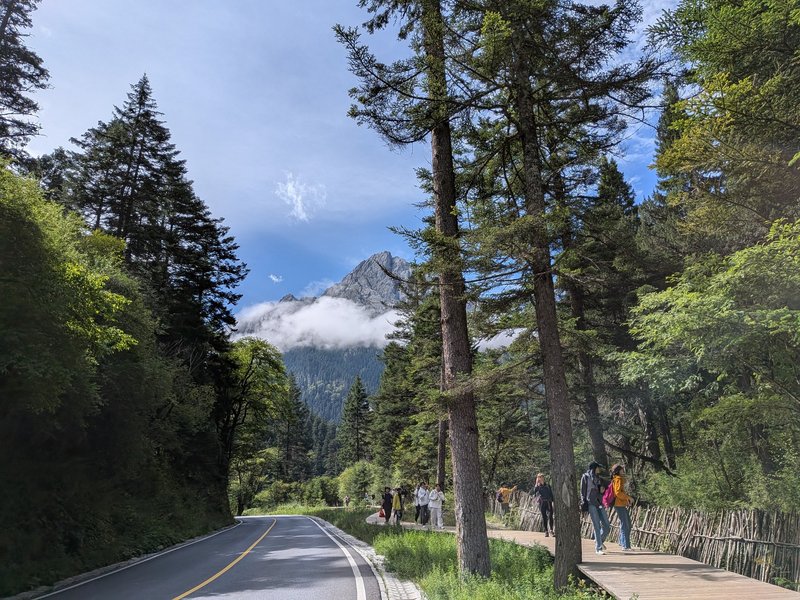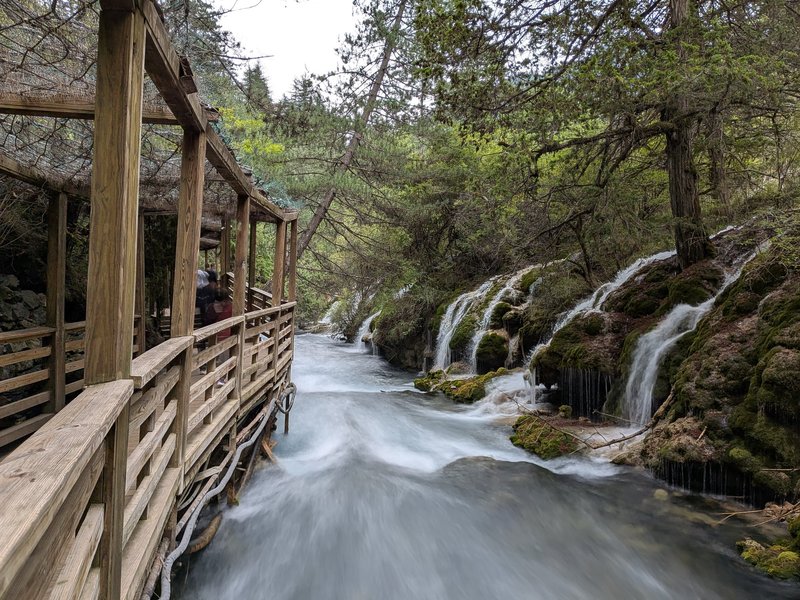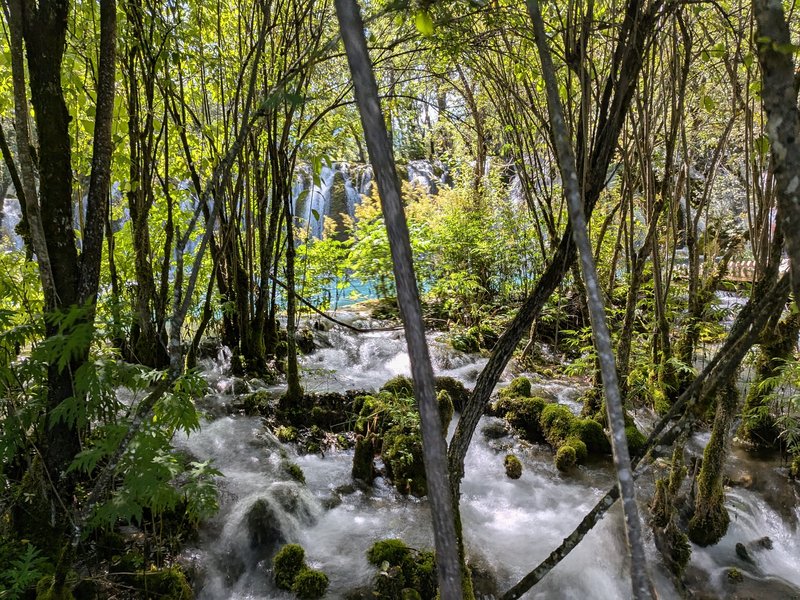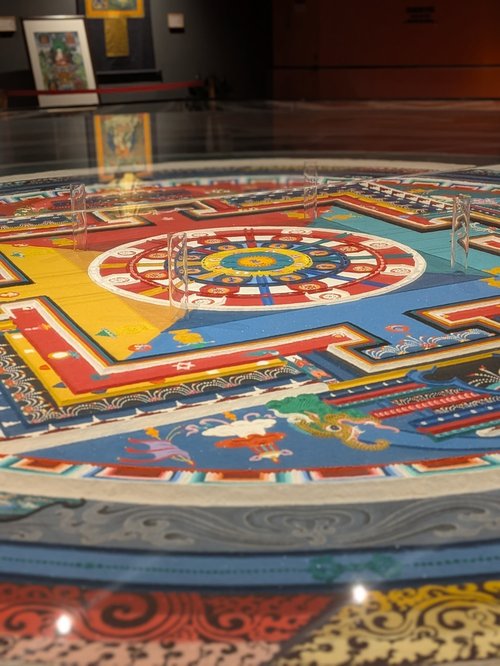Jiuzhaigou is a water-and-mountain wonderland, bursting with turquoise pools, breathtaking mountain vistas, and spectacular waterfalls. It's not without reason that it ranks as China's top Natural World Heritage Site and one of its top four overall.

We spent a day hiking in the park. From the park entrance, we took the shuttle bus up to the Primeval Forest bus stop at 3200 meters altitude, then followed the water's flow down to the Nuorilang Falls, and ended our visit in the Tibetan village of Shuzheng. Admittedly, some legs we hopped onto the shuttle bus as shortcut.
Our original plan was to spent 1.5 days in the park. We had arrived from Chengdu by lunch time the day prior and were hoping to visit the lower parts of Jiuzhaigou in the afternoon. However, we discovered that the park had already stopped selling tickets for the day. This highlighted a crucial point: tickets must be bought online and in advance.

What initially felt arbitrary turned out to be the park's method of crowd control. Jiuzhaigou is immensely popular with domestic tourists, and to protect the fragile natural environment, strict limits are enforced, including a daily visitor cap.
This brings me to the main challenge for anyone who has experienced other great national parks. In vast places like many American parks, where visitor numbers are low relative to the size - I recall having Los Alerces mostly to myself - you get more freedom and the visit feels more intimate.
In China, this system would simply fail. The sheer volume of people necessitates tight crowd control. The Chinese solution is a very binary approach to access: the majority of the park is strictly off-limits to visitors. You won't find any hidden trails or secret gems. Access is confined to official, purpose-built plank trails that effectively 'railroad' you through the national park.
While this structured access can feel restrictive, it arguably strikes a reasonable balance between allowing people to experience the natural beauty and preserving the wildlife (which includes pandas). Ultimately, though, this highly limited access is why I couldn't quite award the park a five-star rating.
Jiuzhaigou vs Huanglong
Like Els, we wondered whether Huanglong and Jiuzhaigou are truly distinct national parks. They’re less than 50 kilometers apart and sit within the same geographical region. Yet, both are unique in their own right.

In Jiuzhaigou, the stars are the mountain scenery, the vibrant coloured pools, and the towering waterfalls. Huanglong, by contrast, is centred more around one single, enormous waterfall, its famous calcite pools, and its strong Taoist heritage. (One could reasonably argue it should be a mixed-site inscription.)
It’s also worth noting that Jiuzhaigou is home to native pandas. I think there's a strong case to be made for inscribing it as an additional Giant Panda Sanctuary.
Getting There
Thanks to China's high-speed rail, what used to be a full-day odyssey is nowadays a relatively relaxed affair. There is a high-speed train station serving both Huanglong and Jiuzhaigou. From the station, you can take a shuttle bus or arrange a private transfer via e.g. trip.com. On arrival, we were offered a surprisingly cheap ride 120 RMB by a private driver. There are some minibuses running the route, but they often stop and reshuffle passengers; personally, I'd aim for private transport for a smoother journey.
Tickets
You cannot buy tickets on site. You must reserve them online in advance. The easiest option for international tourists is trip.com. (Ensure you choose English as your language, as some tickets may not appear when using, e.g., German as language.) As far as we could tell, foreign tickets always include the shuttle bus. Your ticket will be registered against your passport and you enter with your passport.
Getting Around
The park is shaped like a 'Y'. You arrive at the visitor centre (one leg), and shuttles then run via Shuzheng Village to Nuorilang, where the routes split. The two endpoints are the Primeval Forest and the Long Lake. While the system was a little confusing at first for non-Chinese, we eventually figured it out.
As far as I can tell, the main highlights are along the Primeval Forest route, so if you only have one day, this is where you should head (and where we spent our time). From the Primeval Forest, there are trails all the way to the exit, but you can easily hop on and off the shuttle bus at several stops. A nice bonus is that the paths generally run downhill. There are also several shops in the park, so you won't go hungry or thirsty. We spent a full day exploring the length of the Primeval Forest side down to the village.
One more practical comment on crowd control: The buses also function to shuffle people out of the park. After lunch/In the afternoon, they will stop taking passengers uphill (into the park) and only take visitors downhill in the direction of the exit.
Where to Stay
Jiuzhaigou has various hotels within easy walking distance of the park entrance and just outside the park boundaries. Given the elevated hotel prices in Jiuzhaigou, you could also stay slightly further afield and simply take a taxi.
While You're There
You'll almost certainly want to tick off Huanglong as well. The standard itinerary is to visit Huanglong on arrival from Chengdu, then do Jiuzhaigou the following day before returning to Chengdu that evening.
The high-speed rail occasionally stops at Maoxian. From there, you should be able to visit the Dialous (Tibetan watchtowers). Be aware that the closest location consists of two villages, one of which (I think it's called eagle's nest) requires a 1 hour hike (one way), so make sure to allocate enough time.

We used our unexpectedly free afternoon to visit the nearby Tibetan Culture Museum. It also seemed there are other scenic areas beyond Jiuzhaigou worth exploring. From our car window, we certainly felt that a visit to a traditional village (if accessible) would be a lovely addition to the trip.
More on
Comments
No comments yet.
